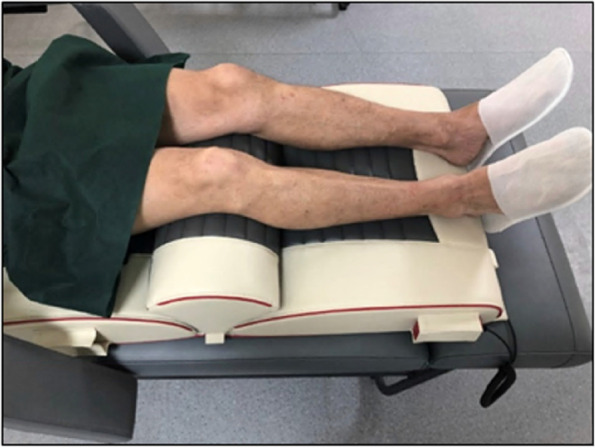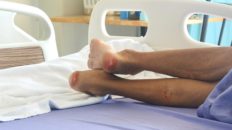Knee degeneration is a common orthopaedic condition that affects millions of people worldwide. Although these degenerations are often associated with ageing, they can also occur in younger people for a variety of reasons. In this article, we will discuss the causes, symptoms and available treatments for knee degeneration.
Causes of knee osteoarthritis
The causes of knee osteoarthritis are very varied. They can be caused by one factor or many at once. The process of ageing is one of the main causes of knee osteoarthritis. As the body ages, the articular cartilage that protects the bones from wear and tear can wear down and reduce its elasticity. Another cause is excess weight. Overweight and obesity are key risk factors for knee degeneration. The extra strain on the knee joints can lead to accelerated wear and tear of the articular cartilage. In younger people, injuries are often the cause of knee degeneration. This indicates sports injuries, car accidents or other injuries to the knee joints can damage the articular cartilage and lead to degeneration. A tendency to knee degeneration can be hereditary. If there is a family history of the condition, there is a higher risk of it occurring in offspring.
Symptoms of knee osteoarthritis
Symptoms of knee osteoarthritis can vary depending on the severity of the condition. Here are some of the most common symptoms:
- Pain: Pain in the knee area is one of the most troublesome symptoms of arthritis. It can be moderate to severe and can occur both during physical activity and at rest.
- Stiffness: People with knee osteoarthritis often experience joint stiffness, especially after prolonged periods of rest.
- Reduced mobility: Reduced ability to bend and straighten the knee joints is another characteristic symptom of arthritis.
- Crackling or popping in the joint: Sounds such as crackling or popping in the knee joint can accompany movement and are often a sign of cartilage damage.
Treatment methods for knee osteoarthritis
Treatment of knee osteoarthritis depends on the severity of the condition and the individual patient’s needs. Here are some commonly used treatment methods:
- Physical therapy: Physical therapies including vibration therapy can help to strengthen the muscles around the knee joint and improve range of motion, which can provide relief from arthritis.
- Pain medications: Painkillers, such as non-steroidal anti-inflammatory drugs (NSAIDs), can help relieve pain and inflammation.
- Steroid injections: steroid injections into the knee joint can help reduce inflammation and pain.
- Supplements and diet: Certain supplements, such as glucosamine and chondroitin, can support joint health. A healthy diet and maintaining a healthy weight also play an important role.
- Surgery: In cases of advanced knee osteoarthritis, surgery such as arthroscopy, knee replacement or osteotomy may be required.
Osteoarthritis
Osteoarthritis (OA) is one of the most commonly recorded diseases in clinical practice. Vibration therapy is used to treat this disease.
A total of 32 participants, divided into two groups, took part in the 2019-2021 study. Sixteen patients were included in the group treated with vibrotherapy. The control group (without vinotherapy) also included 16 people. The age of the subjects included in the study ranged from 42 to 79 years (mean 64.28 years), their mean body weight was 82.18 kg and their body height was 1.62 m. Patients included in the study were diagnosed with advanced osteoarthritis of the knee. The progression of degenerative changes was assessed by a specialist in orthopaedics and musculoskeletal traumatology. The knee joint, which had more advanced degenerative changes, was considered for analysis.
Use of vibration therapy in the study
Vibration therapy was performed using a Vitberg medical device (previous model of the Vitberg Recovery System series). The subjects participated in a 3-week cycle of vibrotherapy or sham therapy, lasting approximately 60 minutes each, in a semi-recumbent position (2 treatments of 30 minutes each). The vibrotherapy treatments were performed in a number of 15, divided into 3 treatment series, for 3 weeks (5 treatments on consecutive 5 treatment days), once a day and included both knee joints.

Study results
After 3 weeks (15 sessions) of vibration therapy, there was a reduction in pain and improvement in mobility. There was a more significant improvement in the vibrotherapy group than the control group in pain relief on the scale, knee flexion at the last session. KOOS scores with pain score, symptoms, activities of daily living, sports and recreational functioning and knee-related quality of life improved more in the vibration therapy group than in the control group. Effects lasted up to four weeks in the vibration group. No adverse events were reported.
How vibrotherapy works
Vibrotherapy uses vibrations with the right parameters to stimulate tissues and muscles around the joints. In the case of knee arthritis, vibrotherapy can provide many benefits. Vibration stimulates blood circulation around the knee joints. This can deliver more oxygen and nutrients to the damaged tissues, which helps the healing and regeneration process of the joint cartilage. Vibrotherapy can help to increase the strength of the muscles around the knee joints. Stronger muscles can help stabilise the joints, which is important in cases of arthritis, as weak muscles can lead to additional stress on the joints. Additionally, vibrotherapy affects pain receptors and reduces the pain experienced. This can help patients with knee osteoarthritis to reduce discomfort and improve quality of life. When applied appropriately, vibration helps to relax muscles and stimulate joints, which can lead to an increased range of movement in the knee joints. This can be particularly beneficial for people who experience joint stiffness. Studies indicate that vibrotherapy reduces inflammation. Appropriate vibration helps to reduce inflammation in the knee joints. With arthritis, inflammation can contribute to cartilage damage in the joint, so reducing inflammation is important. Vibrotherapy can accelerate the healing process of damaged tissues in the knee joint area. This helps patients return to physical activity and daily routines faster. With its beneficial effects on pain and inflammation, vibrotherapy can help reduce the need for pain medication.
Data from the study described here showed that the use of variable frequency, low amplitude vibration in patients with knee osteoarthritis is a safe and effective therapy. What is important to note: just 3 weeks of treatments resulted in relief for a minimum of 1 month! It is important to use vibrotherapy systematically to counteract osteoarthritis. Knee osteoarthritis is a condition that can significantly affect patients’ quality of life. It is important to recognise this condition early and treat it appropriately to minimise pain, restore mobility and prevent further progression of osteoarthritis. Those suffering from pain or other knee-related symptoms should consult a doctor who can recommend appropriate therapy.
Based on:
Pasterczyk-Szczurek A, Golec J, Golec E. Effect of low-magnitude, variable-frequency vibration therapy on pain threshold levels and mobility in adults with moderate knee osteoarthritis-randomized controlled trial. BMC Musculoskelet Disord. 2023 Apr 13;24(1):287. doi: 10.1186/s12891-023-06334-9. PMID: 37055733; PMCID: PMC10099927.




